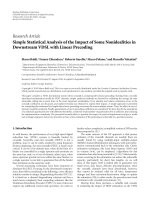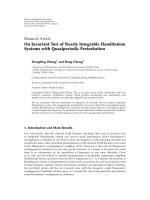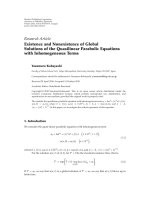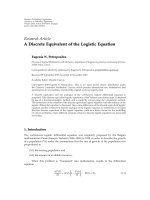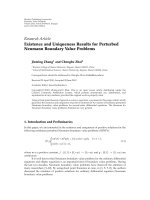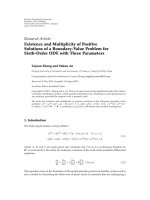báo cáo hóa học:" Research Article Existence and Nonexistence of Global Solutions of the Quasilinear Parabolic Equations with Inhomogeneous Terms" pot
Bạn đang xem bản rút gọn của tài liệu. Xem và tải ngay bản đầy đủ của tài liệu tại đây (496.29 KB, 11 trang )
Hindawi Publishing Corporation
Advances in Difference Equations
Volume 2010, Article ID 451619, 11 pages
doi:10.1155/2010/451619
Research Article
Existence and Nonexistence of Global
Solutions of the Quasilinear Parabolic Equations
with Inhomogeneous Terms
Yasumaro Kobayashi
Faculty of Urban Liberal Arts, Tokyo Metropolitan University, Hachioji, Tokyo 192-0397, Japan
Correspondence should be addressed to Yasumaro Kobayashi,
Received 20 April 2010; Accepted 14 October 2010
Academic Editor: Abdelkader Boucherif
Copyright q 2010 Yasumaro Kobayashi. This is an open access article distributed under the
Creative Commons Attribution License, which permits unrestricted use, distribution, and
reproduction in any medium, provided the original work is properly cited.
We consider the quasilinear parabolic equation with inhomogeneous term u
t
Δu
m
x
σ
u
p
fx,
ux, 0u
0
x,where0 ≤ fx, u
0
x ∈ CR
N
, m>0, p>max{1,m},andσ>−2,
x :|x|
2
1
1/2
. In this paper, we investigate the critical exponents of this equation.
1. Introduction
We consider the quasi-linear parabolic equation with inhomogeneous term
u
t
Δu
m
x
σ
u
p
f
x
x ∈ R
N
,t>0
,
u
x, 0
u
0
x
x ∈ R
N
,
1.1
where 0 ≤ fx, u
0
x ∈ CR
N
, m>0, p>max{1,m},andσ>−2, x :|x|
2
1
1/2
.
For the solution ux, t of 1.1,letT
∗
> 0 be the maximal existence time, that is,
T
∗
: sup
T>0; sup
t∈
0,T
u
·,t
∞
< ∞
.
1.2
If T
∗
∞, we say that ux, t is a global solution; if T
∗
< ∞, we say that ux, t blows up in
finite time.
2 Advances in Difference Equations
For quasi-linear parabolic equations, the authors of 1–5 and so on. study the
homogeneous equations i.e., fx ≡ 0in1.1. Baras and Kersner 1 proved that 1.1
with m 1andfx ≡ 0 has a global solution, two constants c
1
and c
2
depending on N and
p exist such that
lim inf
r →∞
r
−2/p−1
|x|<r
dx
x
σ/p−1
≥ c
1
u
0
dx,
lim inf
|x|→∞
x
σ2
u
0
x
p−1
≤ c
2
.
1.3
Mochizuki and Mukai 2 and Qi 4 study the case m>0, σ 0, Pinsky 3 studies the case
m 1, σ>−2, and Suzuki 5 studies the case m ≥ 1, −∞ <σ<∞. The following two results
are proved by them:
1 if p ≤ p
∗
m,σ
, then every nontrivial solution ux, t of 1.1 blows up in finite time;
2 if p>p
∗
m,σ
, then 1.1 has a global solution for some initial value u
0
x,
where p
∗
m,σ
m 2 σ/N for N ≥ 2, σ>−2andforN 1, σ>−1, p
∗
m,σ
m 1forN 1,
σ ≤−1. This p
∗
m,σ
is called the critical exponent.
On the other hand, 6–9 and so on. study the inhomogeneous equations i.e., fx
/
≡ 0
in 1.1.Bandleetal.6 study the case m 1, σ 0, and Zeng 8 and Zhang 9 study the
case σ 0. In this paper, we investigate the critical exponents of 1.1 in the case fx
/
≡ 0. Our
results are as follows.
Theorem 1.1. Suppose that N ≥ 3, σ>−2, m>N − 2/N σ, and p>max{1,m}.Put
p
∗
m,σ
:
m
N σ
N − 2
.
1.4
a If p ≤ p
∗
m,σ
, then every nontrivial solution ux, t of 1.1 blows up in finite time.
b If p>p
∗
m,σ
, u
0
x ≤ C
1
x
−2σ/p−m
, and fx ≤ C
2
x
−m2σ/p−m−4
,then1.1 has
a global solution for some constants C
1
and C
2
.
Theorem 1.2. Suppose that N 1, 2, σ ≥−2, m>0, and p>max{1,m}. Then every nontrivial
solution ux, t of 1.1 blows up in finite time.
Remark 1.3. Theorems 1.1 and 1.2 are the extension of the results of 8.Ifweputσ 0in
these theorems, the same results as Theorem 1 in 8 are obtained.
We will prove Theorem 1.1a and b in Sections 3 and 4, respectively. The proof of
Theorem 1.2 is included in the proof of Theorem 1.1a.
In the following, R and T are two given positive real numbers greater than 1. C is a
positive constant independent of R and T, and its value may change from line to line.
2. Preliminaries
In this section, we first give the definition of a solution for Problem 1.1 and then cite the
comparison theorem and a known result.
Advances in Difference Equations 3
Definition 2.1. A continuous function u ux, t is called a solution of Problem 1.1 in Q
T
≡
R
N
× 0,T if the following holds:
i ∇
x
u
m
∈ L
2
loc
R
N
;
ii for any bounded domain D ⊂ R
N
and for all ψ ∈ C
2
D × 0,T and vanishing on
∂D × 0,T,
τ
0
D
u∂
t
ψ −∇u
m
∇ψ
x
σ
u
p
ψ fψ
dx dt
D
u
x, ·
ψ
x, ·
τ
0
dx,
2.1
for all τ ∈ 0,T.
Lemma 2.2 the comparison theorem. Let u, v ∈ C0, T; L
2
loc
Ω, ∇u
m
, ∇v
m
∈ L
2
0, T;
L
2
loc
Ω, and satisfy
u
t
− Δu
m
≤ v
t
− Δv
m
,
x, t
∈ Ω
T
,
u ≤ v,
x, t
∈ ∂Ω
T
.
2.2
Then u ≤ v for all x, t ∈ Ω
T
,whereΩ is a bounded domain in R
N
with smooth boundary ∂Ω or
ΩR
N
and Ω
T
Ω× 0,T.
Lemma 2.3 the monotonicity property. Let u
x be a nonnegative sub-solution to the stationary
problems of Problem 1.1. Then the positive solution ux, t with initial data u
x is monotone
increasing to t.
3. Proof of Theorem 1.1(a)
We first consider the following problem:
u
t
Δu
m
x
σ
u
p
f
x
x ∈ R
N
,t>0
,
u
x, 0
0
x ∈ R
N
.
3.1
It is clear that the positive solution of Problem 3.1 is a sub-solution of Problem 1.1. If every
positive solution of Problem 3.1 blows up in finite time, then, by Lemma 2.2, every positive
solution of Problem 1.1 also blows up in finite time. Therefore, we only need to consider
Problem 3.1.
The stationary problem of Problem 3.1 is as follows:
Δu
m
x
σ
u
p
f
x
0
x ∈ R
N
. 3.2
It is obvious that 0 is a sub-solution of Problem 3.2 and does not satisfy Problem 3.2.Thus,
by making use of Lemmas 2.2 and 2.3, the positive solution of Problem 3.1 is monotone
increasing to t.
4 Advances in Difference Equations
We argue by contradiction. Assume that Problem 3.1 has a global positive solution
for p ≤ p
∗
m,σ
.
Let ϕr and ηt be two functions in C
∞
0, ∞, and satisfy
i 0 ≤ ϕr ≤ 1in0, ∞; ϕr ≡ 1in0, 1, ϕr ≡ 0in2, ∞; −C ≤ ϕ
r ≤ 0,
|ϕr|≤C;
ii 0 ≤ ηt ≤ 1in0, ∞; ηt ≡ 1in0, 1, ηt ≡ 0in2, ∞; −C ≤ η
t ≤ 0.
For R>1andT>1, define Q
R,T
≡ B
2R
× 0, 4T,andletΨr, tϕ
R
rη
T
t be a cut-off
function, where ϕ
R
rϕr/R, η
T
tηt/2T. It is easy to check that
−
C
R
≤
dϕ
R
r
dr
≤ 0,
d
2
ϕ
R
r
dr
2
≤
C
R
2
, −
C
2T
≤
dη
T
t
dt
≤ 0. 3.3
Let
I
R
Q
R,T
x
σ
u
p
Ψ
s
dxdt,
3.4
where s>1 is a positive number to be determined. Then
I
R
Q
R,T
−u∂
t
Ψ
s
∇u
m
∇Ψ
s
− fΨ
s
dx dt
B
2R
ux, ·Ψr, ·
s
4T
0
dx
−
Q
R,T
uϕ
s
R
dη
s
T
dt
dx dt
Q
R,T
∇u
m
η
s
T
∇ϕ
s
R
dx dt −
Q
R,T
fΨ
s
dx dt
B
2R
u
x, ·
ϕ
R
r
s
η
T
·
s
4T
0
dx
−
Q
R,T
uϕ
s
R
dη
s
T
dt
dx dt −
Q
R,T
u
m
η
s
T
Δϕ
s
R
dx dt −
Q
R,T
fΨ
s
dx dt
4T
0
|x|2R
u
m
η
s
T
∂ϕ
s
R
∂ν
dS dt.
3.5
Since
R
N
fxdx > 0, there exist δ>0andR
0
> 1 such that
B
R
fxdx ≥ δ for R>R
0
:
Q
R,T
fΨ
s
dx dt
4T
0
η
s
T
B
2R
fϕ
s
R
dx dt ≥
2T
T
B
R
fdxdt ≥ δT.
3.6
Hence, by the definition of ϕ
R
and η
T
, we have
I
R
≤−
4T
2T
B
2R
uϕ
s
R
dη
s
T
dt
dx dt −
4T
0
B
2R
\B
R
u
m
η
s
T
Δϕ
s
R
dx dt − δT.
3.7
Advances in Difference Equations 5
Since Δϕ
s
R
sϕ
s−1
R
Δϕ
R
ss − 1ϕ
s−2
R
|∇ϕ
R
|
2
and
Δϕ
R
r
d
2
ϕ
R
r
dr
2
N − 1
r
dϕ
R
r
dr
,
∇ϕ
R
2
dϕ
R
r
dr
2
,
3.8
we obtain from 3.3 that
Δϕ
s
R
≤ sϕ
s−1
R
C
R
2
N − 1
R
·
C
R
s
s − 1
ϕ
s−2
R
C
R
2
≤
C
R
2
ϕ
s−2
R
3.9
in B
2R
\ B
R
and
dη
s
T
dt
sη
s−1
T
dη
T
dt
≥−sη
s−1
T
C
2T
≥−
C
T
η
s−1
T
3.10
in 2T, 4T.Thus,3.7 becomes
I
R
≤
C
T
4T
2T
B
2R
uΨ
s−1
dx dt
C
R
2
4T
0
B
2R
\B
R
u
m
Ψ
s−2
dx dt − δT.
3.11
Let s be large enough such that s − 1p ≥ s and s − 2p/m ≥ s,andletA
σ
R be as follows:
A
σ
R
⎧
⎨
⎩
R
N−σ/p−1
σ<N
p − 1
,
log
R 1
σ ≥ N
p − 1
.
3.12
Then, by making use of Young’s inequality, we have
C
T
4T
2T
B
2R
uΨ
s−1
dx dt
≤
4T
2T
B
2R
1
4
p
p
x
σ
u
p
Ψ
s−1p
4
q
q
x
−σq/p
C
q
T
−q
dx dt
≤
1
4
4T
0
B
2R
x
σ
u
p
Ψ
s
dx dt CT
−p/p−1
4T
2T
B
2R
x
−σ/p−1
dx dt
≤
1
4
I
R
CT
1−p/p−1
A
σ
R
,
3.13
6 Advances in Difference Equations
where 1/p 1/q 1and
C
R
2
4T
0
B
2R
\B
R
u
m
Ψ
s−2
dx dt
≤
4T
0
B
2R
\B
R
1
4
p
p
x
σ
u
mp
Ψ
s−2p
4
q
q
x
−σq
/p
C
q
R
−2q
dx dt
≤
1
4
4T
0
B
2R
x
σ
u
p
Ψ
s
dx dt CR
−2p/p−m
4T
0
B
2R
\B
R
x
−mσ/p−m
dx dt
≤
1
4
I
R
CTR
−2p/p−m
R
N−mσ/p−m
,
3.14
where p
p/m,1/p
1/q
1. Thus, 3.11 becomes
I
R
≤
1
2
I
R
T
CT
−p/p−1
A
σ
R
CR
N−2pmσ/p−m
− δ
. 3.15
For N ≥ 3, since σ>−2, 1/p
1/q
1, and max{1,m} <p≤ mN σ/N − 2, we have
N −
2p mσ
p − m
N − 2
p −
N σ
m
p − m
≤ 0.
3.16
For N 2, since σ ≥−2, m>0, and p>max{1,m}, we have
2 −
2p mσ
p − m
−
2 σ
m
p − m
≤ 0.
3.17
For N 1, since σ ≥−2,m>0, and p>max{1,m}, we have
1 −
2p mσ
p − m
−p −
1 σ
m
p − m
<
−
2 σ
m
p − m
≤ 0.
3.18
Let T ≥ A
σ
R
p−1/p
such that T
−p/p−1
A
σ
R ≤ 1, then
I
R
≤ CT, 3.19
that is,
4T
0
B
2R
x
σ
u
p
Ψ
s
dx dt ≤ CT. 3.20
Thus
2T
T
B
R
x
σ
u
p
dx dt ≤ CT.
3.21
Advances in Difference Equations 7
By the integral mean value theorem, there exists t
1
∈ T, 2T such that
2T
T
B
R
x
σ
u
p
dx dt T
B
R
x
σ
u
x, t
1
p
dx ≤ CT,
3.22
that is,
B
R
x
σ
u
x, t
1
p
dx ≤ C. 3.23
Since T is a large positive number and a random selection, and ux, t is monotone increasing
to t, there exists a positive number TR > 1 for any fixed R>R
0
such that, for all t>TR,
B
R
x
σ
u
x, t
p
dx ≤ C.
3.24
By the monotone increasing property of ux, t,
B
R
x
σ
ux, t
p
dx also is increasing to t.This,
combined with 3.24, yields that the limit I
∞
R
exists such that
I
∞
R
≡ lim
t →∞
B
R
x
σ
u
x, t
p
dx ≤ C.
3.25
Since ux, t is nonnegative, I
∞
R
is monotone increasing to R. This, combined with 3.25,
yields that lim
R →∞
I
∞
R
exists. Thus, for any small ε>0, there exists a large positive constant
which still is denoted by R
0
, such that, for R>R
0
,
lim
t →∞
B
2R
\B
R
x
σ
u
x, t
p
dx ≡ I
∞
2R
− I
∞
R
<ε.
3.26
Hence, by similar argument as that in 3.24, there exists a large positive number TR > 1
such that
B
2R
\B
R
x
σ
u
x, t
p
dx < ε, ∀t>T
R
.
3.27
On the other hand, we argue as in 6, 10.Letξx ∈ C
2
R
N
be a positive function
satisfying.
i 0 ≤ ξx ≤ 1inR
N
; ξx ≡ 1inB
1
, ξx ≡ 0inB
c
2
;
ii ∂ξ/∂ν 0on∂B
2
\ B
1
;
iii for any α ∈ 0, 1, there exists a positive constant C
α
such that |Δξ|≤C
α
ξ
α
.
Let R and TR be as defined in 3.26 and 3.27. Multiplying 3.1 by ξ
R
xξx/R
and then integrating by parts in R
N
, we have
d
dt
R
N
uξ
R
dx
B
2R
\B
R
u
m
Δξ
R
dx
R
N
x
σ
u
p
ξ
R
dx
R
N
fξ
R
dx.
3.28
8 Advances in Difference Equations
By the definition of ξ
R
x,H
¨
older’s inequality, and 3.27, we have
B
2R
\B
R
u
m
Δξ
R
dx
≤
C
α
R
2
B
2R
\B
R
u
m
ξ
α
R
dx
≤
C
α
R
2
B
2R
\B
R
x
σ
u
mp
dx
1/p
B
2R
\B
R
x
−σq
/p
ξ
αq
R
dx
1/q
≤
C
α
R
2
B
2R
\B
R
x
σ
u
p
dx
m/p
B
2R
\B
R
x
−mσ/p−m
dx
p−m/p
≤ Cε
m/p
R
N−mσ/p−mp−m/p−2
≤ Cε
m/p
,
3.29
where p
p/m,1/p
1/q
1, since
N −
mσ
p − m
p − m
p
− 2
N − 2
p −
N σ
m
p
≤ 0.
3.30
Let F
R
t
R
N
uξ
R
dx and G
R
t
R
N
x
σ
u
p
ξ
R
dx. Then, by making use of 3.29 and
R
N
fxdx ≥ δ for R>R
0
, 3.28 becomes
F
R
t
≥ G
R
t
− Cε
m/p
δ.
3.31
Thus, let ε be small enough such that Cε
m/p
≤ δ/2, then F
R
t ≥ G
R
tδ/2.
Let t
0
>TR. By making use of H
¨
older’s inequality, we obtain that
F
R
t
≤
R
N
x
σ
u
p
ξ
R
dx
1/p
R
N
x
−σq/p
ξ
R
dx
1/q
≤ G
R
t
1/p
B
2R
x
−σ/p−1
dx
p−1/p
≤ CG
R
t
1/p
A
σ
R
p−1/p
,
3.32
where 1/p 1/q 1. Thus, we obtain that
t
t
0
F
R
s
p
ds ≤ CA
σ
R
p−1
t
t
0
G
R
s
ds ≤ CA
σ
R
p−1
t
t
0
F
R
s
ds
≤ CA
σ
R
p−1
F
R
t
− F
R
t
0
.
3.33
Advances in Difference Equations 9
Since F
R
t ≥ 0 for all t ≥ 0, we have
F
R
t
≥ CA
σ
R
−p1
t
t
0
F
R
s
p
ds F
R
t
0
≥ CA
σ
R
−p1
t
t
0
F
R
s
p
ds.
3.34
Let gt
t
t
0
F
R
s
p
ds, then
g
t
F
R
t
p
≥ CA
σ
R
−pp−1
g
t
p
.
3.35
Let t
1
>t
0
such that gt
1
> 0. Since p>1, by solving the differential inequality 3.35 in t
1
,t,
we have
t
t
1
g
s
g
s
p
ds ≥ CA
σ
R
−pp−1
t
t
1
ds,
g
t
1−p
≤ g
t
1
1−p
− C
p − 1
A
σ
R
−pp−1
t − t
1
,
g
t
≥
g
t
1
1−p
− C
p − 1
A
σ
R
−pp−1
t − t
1
−1/p−1
.
3.36
Thus, there exists T
1
with t
1
<T
1
≤ t
1
Cp − 1
−1
A
σ
R
pp−1
gt
1
1−p
, such that lim
t↑T
1
gt
∞, which implies that gt and then u blow up in finite time. It contradicts our assumption.
Therefore, every positive solution of Problem 3.1 blows up in finite time. Hence, every
positive solution of Problem 1.1 blows up in finite time.
4. Proof of Theorem 1.1(b)
In this section, we prove that for p>mN σ/N −2, there exist some fx and u
0
x, such
that Problem 1.1 admits a global positive solution.
We first consider the stationary problem of Problem 1.1 as follows:
Δu
m
x
σ
u
p
f
x
0
x ∈ R
N
. 4.1
Let vxC
1
x
−s
, where s 2 σ/p − m and the positive constant C
1
satisfies
C
p−m
1
ms
N − ms − 2
m
2 σ
N − 2
p −
N σ
m
p − m
2
> 0.
4.2
10 Advances in Difference Equations
Then, we have
−Δv
m
ms
2
C
m
1
|
x
|
2
1
−ms/2−1
Δ
|
x
|
2
1
−
ms
ms 2
4
C
m
1
|
x
|
2
1
−ms/2−2
∇
|
x
|
2
1
2
NmsC
m
1
x
−ms−2
− ms
ms 2
C
m
1
|
x
|
2
x
−ms−4
ms
N − ms − 2
C
m
1
x
−ms−2
ms
ms 2
C
m
1
x
−ms−4
.
4.3
Since C
p−m
1
msN − ms − 2 and −ms − 2 σ − ps, we have
−Δv
m
C
p
1
x
σ−ps
C
2
x
−ms−4
x
σ
v
p
C
2
x
−ms−4
,
4.4
where C
2
msms 2C
m
1
.Thus,iffx ≤ C
2
x
−ms−4
and u
0
x ≤ vx, then v is
a supersolution of Problem 1.1. It is obvious that 0 is s sub-solution of Problem 1.1.
Therefore, by the iterative process and the comparison theorem, Problem 1.1 admits a global
positive solution.
Acknowledgments
This paper was introduced to the author by Professor Kiyoshi Mochizuki in Chuo University.
The author would like to thank him for his proper guidance. The author would also like
to thank Ryuichi Suzuki for useful discussions and friendly encouragement during the
preparation of this paper.
References
1 P. Baras and R. Kersner, “Local and global solvability of a class of semilinear parabolic equations,”
Journal of Differential Equations, vol. 68, no. 2, pp. 238–252, 1987.
2 K. Mochizuki and K. Mukai, “Existence and nonexistence of global solutions to fast diffusions with
source,” Methods and Applications of Analysis, vol. 2, no. 1, pp. 92–102, 1995.
3 R. G. Pinsky, “Existence and nonexistence of global solutions for u
t
Δu axu
p
in R
d
,” Journal of
Differential Equations, vol. 133, no. 1, pp. 152–177, 1997.
4 Y W. Qi, “On the equation u
t
Δu
α
u
β
,” Proceedings of the Royal Society of Edinburgh. Section A.
Mathematics, vol. 123, no. 2, pp. 373–390, 1993.
5 R. Suzuki, “Existence and nonexistence of global solutions of quasilinear parabolic equations,” Journal
of the Mathematical Society of Japan, vol. 54, no. 4, pp. 747–792, 2002.
6 C. Bandle, H. A. Levine, and Q. S. Zhang, “Critical exponents of Fujita type for inhomogeneous
parabolic equations and systems,” Journal of Mathematical Analysis and Applications, vol. 251, no. 2,
pp. 624–648, 2000.
7 M. Kirane and M. Qafsaoui, “Global nonexistence for the Cauchy problem of some nonlinear reaction-
diffusion systems,” Journal of Mathematical Analysis and Applications, vol. 268, no. 1, pp. 217–243, 2002.
8 X. Zeng, “The critical exponents for the quasi-linear parabolic equations with inhomogeneous terms,”
Journal of Mathematical Analysis and Applications, vol. 332, no. 2, pp. 1408–1424, 2007.
Advances in Difference Equations 11
9 Q. S. Zhang, “Blow-up results for nonlinear parabolic equations on manifolds,” Duke Mathematical
Journal, vol. 97, no. 3, pp. 515–539, 1999.
10 Y W. Qi, “The critical exponents of parabolic equations and blow-up in R
n
,” Proceedings of the Royal
Society of Edinburgh. Section A, vol. 128, no. 1, pp. 123–136, 1998.




